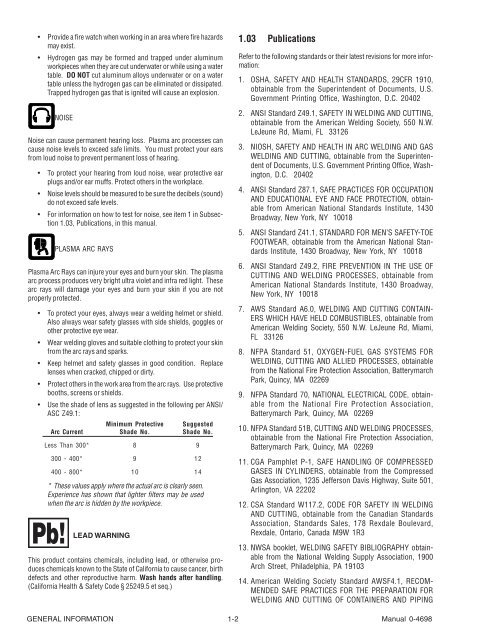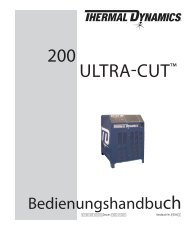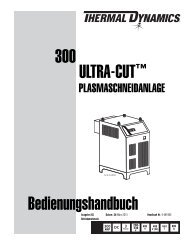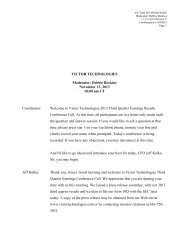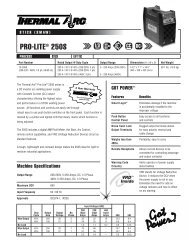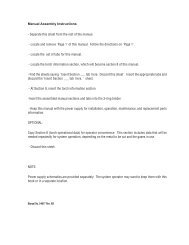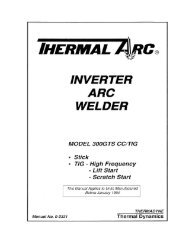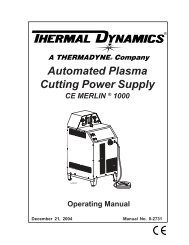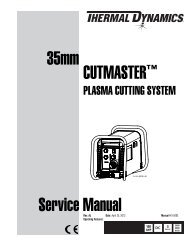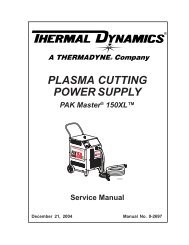CUTSKILL® C-35A - Victor Technologies
CUTSKILL® C-35A - Victor Technologies
CUTSKILL® C-35A - Victor Technologies
You also want an ePaper? Increase the reach of your titles
YUMPU automatically turns print PDFs into web optimized ePapers that Google loves.
Provide a fire watch when working in an area where fire hazards<br />
may exist.<br />
Hydrogen gas may be formed and trapped under aluminum<br />
workpieces when they are cut underwater or while using a water<br />
table. DO NOT cut aluminum alloys underwater or on a water<br />
table unless the hydrogen gas can be eliminated or dissipated.<br />
Trapped hydrogen gas that is ignited will cause an explosion.<br />
NOISE<br />
Noise can cause permanent hearing loss. Plasma arc processes can<br />
cause noise levels to exceed safe limits. You must protect your ears<br />
from loud noise to prevent permanent loss of hearing.<br />
To protect your hearing from loud noise, wear protective ear<br />
plugs and/or ear muffs. Protect others in the workplace.<br />
Noise levels should be measured to be sure the decibels (sound)<br />
do not exceed safe levels.<br />
For information on how to test for noise, see item 1 in Subsection<br />
1.03, Publications, in this manual.<br />
PLASMA ARC RAYS<br />
Plasma Arc Rays can injure your eyes and burn your skin. The plasma<br />
arc process produces very bright ultra violet and infra red light. These<br />
arc rays will damage your eyes and burn your skin if you are not<br />
properly protected.<br />
To protect your eyes, always wear a welding helmet or shield.<br />
Also always wear safety glasses with side shields, goggles or<br />
other protective eye wear.<br />
Wear welding gloves and suitable clothing to protect your skin<br />
from the arc rays and sparks.<br />
Keep helmet and safety glasses in good condition. Replace<br />
lenses when cracked, chipped or dirty.<br />
Protect others in the work area from the arc rays. Use protective<br />
booths, screens or shields.<br />
Use the shade of lens as suggested in the following per ANSI/<br />
ASC Z49.1:<br />
Minimum Protective Suggested<br />
Arc Current Shade No. Shade No.<br />
Less Than 300* 8 9<br />
300 - 400* 9 12<br />
400 - 800* 10 14<br />
* These values apply where the actual arc is clearly seen.<br />
Experience has shown that lighter filters may be used<br />
when the arc is hidden by the workpiece.<br />
LEAD WARNING<br />
This product contains chemicals, including lead, or otherwise produces<br />
chemicals known to the State of California to cause cancer, birth<br />
defects and other reproductive harm. Wash hands after handling.<br />
(California Health & Safety Code § 25249.5 et seq.)<br />
1.03 Publications<br />
Refer to the following standards or their latest revisions for more information:<br />
1. OSHA, SAFETY AND HEALTH STANDARDS, 29CFR 1910,<br />
obtainable from the Superintendent of Documents, U.S.<br />
Government Printing Office, Washington, D.C. 20402<br />
2. ANSI Standard Z49.1, SAFETY IN WELDING AND CUTTING,<br />
obtainable from the American Welding Society, 550 N.W.<br />
LeJeune Rd, Miami, FL 33126<br />
3. NIOSH, SAFETY AND HEALTH IN ARC WELDING AND GAS<br />
WELDING AND CUTTING, obtainable from the Superintendent<br />
of Documents, U.S. Government Printing Office, Washington,<br />
D.C. 20402<br />
4. ANSI Standard Z87.1, SAFE PRACTICES FOR OCCUPATION<br />
AND EDUCATIONAL EYE AND FACE PROTECTION, obtainable<br />
from American National Standards Institute, 1430<br />
Broadway, New York, NY 10018<br />
5. ANSI Standard Z41.1, STANDARD FOR MEN’S SAFETY-TOE<br />
FOOTWEAR, obtainable from the American National Standards<br />
Institute, 1430 Broadway, New York, NY 10018<br />
6. ANSI Standard Z49.2, FIRE PREVENTION IN THE USE OF<br />
CUTTING AND WELDING PROCESSES, obtainable from<br />
American National Standards Institute, 1430 Broadway,<br />
New York, NY 10018<br />
7. AWS Standard A6.0, WELDING AND CUTTING CONTAIN-<br />
ERS WHICH HAVE HELD COMBUSTIBLES, obtainable from<br />
American Welding Society, 550 N.W. LeJeune Rd, Miami,<br />
FL 33126<br />
8. NFPA Standard 51, OXYGEN-FUEL GAS SYSTEMS FOR<br />
WELDING, CUTTING AND ALLIED PROCESSES, obtainable<br />
from the National Fire Protection Association, Batterymarch<br />
Park, Quincy, MA 02269<br />
9. NFPA Standard 70, NATIONAL ELECTRICAL CODE, obtainable<br />
from the National Fire Protection Association,<br />
Batterymarch Park, Quincy, MA 02269<br />
10. NFPA Standard 51B, CUTTING AND WELDING PROCESSES,<br />
obtainable from the National Fire Protection Association,<br />
Batterymarch Park, Quincy, MA 02269<br />
11. CGA Pamphlet P-1, SAFE HANDLING OF COMPRESSED<br />
GASES IN CYLINDERS, obtainable from the Compressed<br />
Gas Association, 1235 Jefferson Davis Highway, Suite 501,<br />
Arlington, VA 22202<br />
12. CSA Standard W117.2, CODE FOR SAFETY IN WELDING<br />
AND CUTTING, obtainable from the Canadian Standards<br />
Association, Standards Sales, 178 Rexdale Boulevard,<br />
Rexdale, Ontario, Canada M9W 1R3<br />
13. NWSA booklet, WELDING SAFETY BIBLIOGRAPHY obtainable<br />
from the National Welding Supply Association, 1900<br />
Arch Street, Philadelphia, PA 19103<br />
14. American Welding Society Standard AWSF4.1, RECOM-<br />
MENDED SAFE PRACTICES FOR THE PREPARATION FOR<br />
WELDING AND CUTTING OF CONTAINERS AND PIPING<br />
GENERAL INFORMATION 1-2 Manual 0-4698


